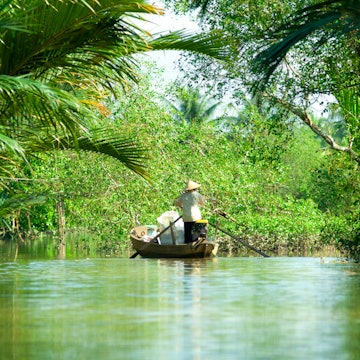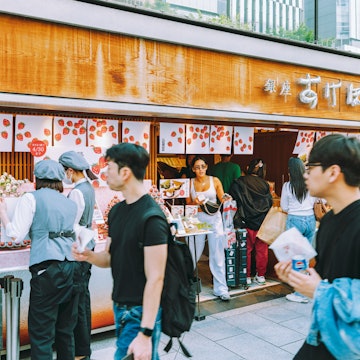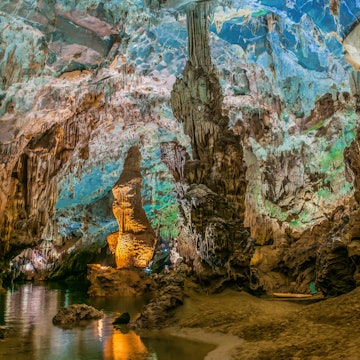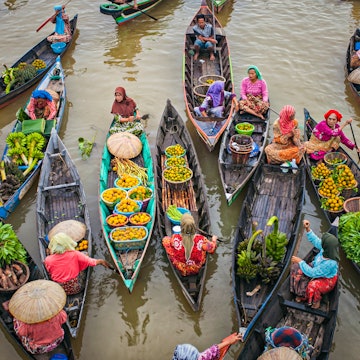

Canal City, a five-floor shopping mall with entertainment and dining in Fukuoka, Japan. EQRoy / Shutterstock
Unlike the sensory overload of Japan’s larger cities, Fukuoka has managed a different, lower-key kind of allure.
Dialing down the overwhelm and spaghetti-like metro maps, this Kyūshū gem puts its renowned easygoing character on full blast. Fukuoka surprises and delights from the get-go with its dreamy six-minute subway commute from the airport direct to downtown, where modern conveniences abound – without the intense crowds.
With its flat and easily walkable streets, mix of immersive attractions and dining culture that effectively ties the entire city together through one collective dinner table, this city gives you plenty to write home about. Here are some of the best things to do in Fukuoka.

1. Join the nightly dinner party at the city’s yatai street food stalls
Nowhere can you experience Fukuoka’s incredible food culture more than when sitting down at a yatai. These street food stalls aren't just a place to eat: they are a way of life, a chance to mingle after the sun goes down, and an opportunity for social intimacy and connection that can be hard to find in big cities.
Fukuoka is home to around 100 independently run yatai. Mostly in the Nakasu, Tenjin and Nagahama areas, they accommodate an average of eight to 10 people at a time. The most popular stretch of yatai for visitors is at the Yatai-mura night market along the Nakasu River. (Keep in mind, though, that you’ll mostly be in the company of other out-of-towners.)
To brush shoulders with a local crowd, venture away from the riverfront and to one of the many more solitary set-ups that dot the map around town. You never know what characters you’ll meet while huddled around the warmth of the grill as friendly banter punctuates the air and sizzling heightens intermittently when another dish hits the hot plate.
Many yatai have a no-mobiles policy to encourage interaction. So put your phone away and fully savor the food and the company.
Local tip: If you’re no longer eating or drinking, the etiquette is to pay up and leave given the small number of seats. Try to limit your stay to around an hour and avoid visiting in large groups. If you don’t know what to order and dietary requirements allow, you can leave it up to the chef’s recommendation by saying “osusume onegaishimasu.”
2. Bask in yesteryear on Hakata Kawabata-dōri shopping street
Hakata Kawabata-dōri is a lively shopping arcade of more than 100 local stores, from clothing and local wares to fresh produce and restaurants. Stretching 400m (1313ft) and with more than 130 years of history, Fukuoka’s oldest shopping street maintains a post-WWII Shōwa-era feel not short on nostalgia.
For a sweet treat, be sure to try the arcade’s specialty red bean soup with grilled mochi cakes at Kawabata Zenzai Hiroba (open weekends and public holidays only) and gaze at the Yamakasa festival float inside.
Planning tip: To experience Kawabata Shopping Street in full swing, it is best visited from midday onward as most shops don’t open until late morning.

3. Honor the deity of learning and culture at the Dazaifu Tenman-gū Shrine
Enveloped in 1100 years of history, Dazaifu Tenman-gū is dedicated to the ninth-century scholar Sugawara Michizane, who is enshrined here as Tenjin, the Shinto deity of learning, culture and the arts. As one of the most important of some 12,000 Tenjin shrines across the country, Dazaifu is especially popular among students wishing to pray for good results during entrance exam season.
Sample the traditional sweet of the shrine, umegaemochi, a crispy rice cake filled with sweetened azuki red-bean paste and imprinted with a plum-blossom crest, the symbol of Dazaifu. Believed to be a favorite flower of Sugawara, the blossoms of the shrine’s 6000 plum trees draw spectacular crowds when they bloom en masse in late winter to early spring.
Planning tip: Dazaifu Tenman-gū is about 30 minutes by public transportation from downtown Fukuoka.

4. Check out the city from Fukuoka Tower and other viewpoints
Head up the 234m (768ft) Fukuoka Tower, the tallest seaside tower in Japan, for unimpeded panoramic views of the city, sea and mountains. The tower is probably most dazzling at night, when its mirrored facade becomes the backdrop to seasonal illumination displays and the view from the 123m (404ft) observation deck turns to a twinkly nightscape.
If you can’t make it to the tower, one of the city’s finer natural locales, Nishi Park, provides a free vantage point with an almost equally impressive view of the city skyline and Hakata Bay – especially come spring, when the park’s 1300 cherry trees are in bloom.
Other free perches include the observation terrace on the rooftop floor of Hakata Station and ACROS Fukuoka, with its striking 50,000-plant outdoor “Step Garden.” Visitors can ascend a series of staircases from the 2nd to the 14th floor and marvel at the variety of plant species. An observation deck at the top floor also operates on weekends and public holidays.
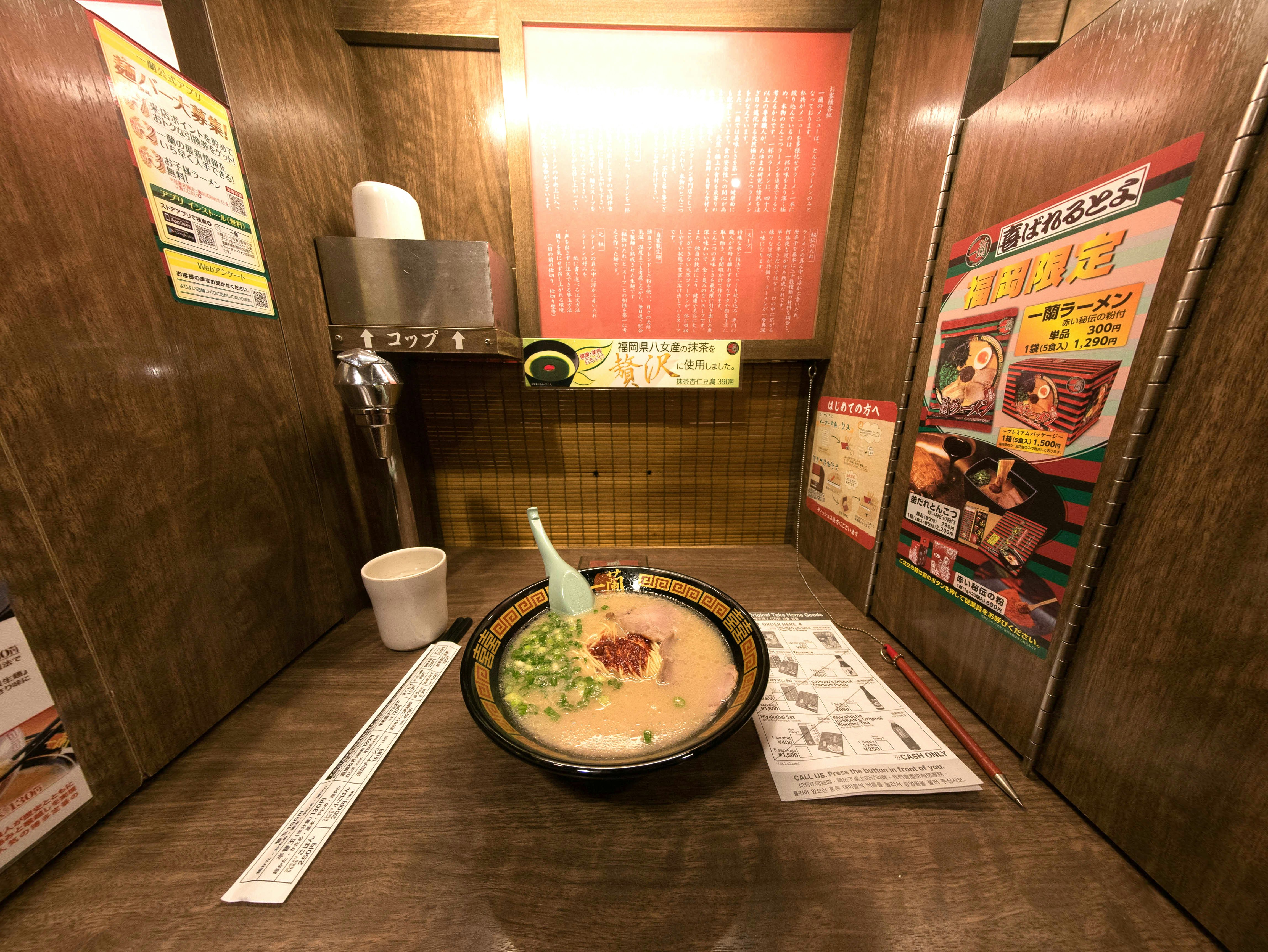
5. Dine on Hakata ramen and other famous regional specialties
When it’s time to eat, Hakata ramen – Fukuoka’s tonkotsu fine-noodle ramen with a pork-bone-broth base – is often top of the culinary list. Although ramen is a typical dish served at yatai, Japanese ramen chain Ichiran is also extremely popular. Fukuoka is where the franchise originated.
Ichiran customers can fully customize their order, from the richness of the soup to the firmness of the noodles, by circling the options on a pre-printed sheet with English translations. The counter seating is probably the most fun, where partitions separate each customer, and your ramen is presented by an anonymous server who passes the bowl from behind a bamboo curtain.
Other must-try local specialties include mentaiko (spicy cod roe), motsunabe (beef or pork intestine with garlic chives, cabbage and other ingredients, boiled in a soy or miso-based soup) and Fukuoka’s huge and juicy amaō strawberries.
Local tip: The most convenient place to pick up local edible souvenirs (including instant Hakata ramen packs and amaō strawberry sweets) is Ming on 1F of Hakata Station, where you’ll find an entire area dedicated to the region’s specialty foods.

6. Stroll Ōhori Park
During daylight hours, nothing beats Ōhori-kōen for a relaxed wander and a window into the everyday lives of Fukuokans.
Encompassing a large tranquil pond, the park is on the grounds of the old Fukuoka Castle, the remnants of which are also free to check out on the park’s outskirts.
Interestingly, the pond itself is part of the former moat system (ōhori is the Japanese word for moat) and now features three small islands – all interconnected by charming bridges – that make the park a popular urban escape.
For locals, Ōhori-kōen serves as a chill hangout, date spot and exercise track. On any given day, you’ll see pockets of activity: friends meeting for coffee at the on-site Starbucks, couples taking swan boats out onto the water, and a steady stream of joggers and dog walkers using the 2km (1.2-mile) trail around the pond.

7. Marvel at the Reclining Buddha at Nanzōin Temple
Nothing quite prepares you for your first gaze upon the Reclining Nehanzō Buddha at Nanzōin Temple. At a staggering 41m (134ft) long, 11m (36ft) high and weighing 300 metric tons (the equivalent of a jumbo jet), the Reclining Buddha dwarfs the better-known sitting statues in Kamakura and Nara.
The reclining pose is a rarity in Japan – it’s more commonly seen in Southeast Asia – and signifies Buddha at the moment of death and entering nirvana. The statue was built in 1995 to house the ashes of the Buddha that were given as a gift to Nanzōin by the country of Myanmar in gratitude for donating medical supplies.
For those seeking good fortune, touching the intricate soles of the Buddha’s feet is said to bring luck. The temple is credited with lottery wins, with the chief priest himself allegedly among the winners.
Planning tip: While the temple is accessible 24/7, gates to the Reclining Buddha are closed at 4:30pm. Visitors should note that exposed tattoos and revealing attire are not permitted.
8. Shop ’til you drop at Canal City
Canal City is Fukuoka’s crown jewel for fashion and lifestyle goods. With an actual 180m (591ft) canal running through it, this chic five-floor shopping mall is a full entertainment and dining complex housing some of Japan’s most well-known stores including Muji, Uniqlo and Francfranc, along with a host of international brands, such as Adidas, Levi’s, Gap and Disney, to appease any shopaholic.
When in need of a break, pop over to neighboring Kushida Shrine, home of the annual Hakata Gion Yamakasa Festival in July. One of the towering festival floats is on display year-round.
Planning tip: Enjoy the fountain displays at the mall’s Sun Plaza every half hour starting at 10am. In the evenings, marvel at the 3D projection mapping show Canal Aqua Panorama on the vast screen.












